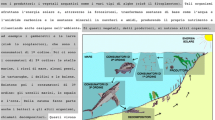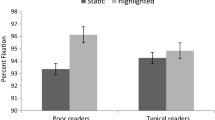Abstract
Science texts often use visual representations (e.g. diagrams, graphs, photographs) to help readers learn science knowledge. Reading an illustrated text for learning is one type of multimedia learning. Empirical research has increasingly confirmed the signaling principle’s effectiveness in multimedia learning. Highlighting correspondences between text and pictures benefits learning outcomes. However, the signaling effect’s cognitive processes and its generalizability to young readers are unknown. This study clarified these aspects using eye-tracking technology and reading tests. Eighty-nine sixth-grade students read an illustrated science text in one of three conditions: reading material with signals, without signals (identical labels of Diagram 1 and Diagram 2 in text and illustration), and with signals combined with reading instructions. Findings revealed that the signaling principle alone cannot be generalized to young readers. Specifically, “Diagram 1” and “Diagram 2” in parentheses mixed with science text content had limited signaling effect for students and reading instructions are necessary. Eye movements reflected cognitive processes of science reading; students who received reading instructions employed greater cognitive effort and time in reading illustrations and tried to integrate textual and pictorial information using signals.




Similar content being viewed by others
References
Ainsworth, S. (2006). DeFT: A conceptual framework for considering learning with multiple representations. Learning and Instruction, 16, 183–198. https://doi.org/10.1016/j.learninstruc.2006.03.001.
Armstrong, R. A. (2014). When to use the Bonferroni correction. Ophthalmic & Physiological Optics, 34, 502–508. https://doi.org/10.1111/opo.12131.
Bartholomé, T., & Bromme, R. (2009). Coherence formation when learning from text and pictures: What kind of support for whom? Journal of Educational Psychology, 101, 282–293. https://doi.org/10.1037/a0014312.
Boucheix, J. M., & Guignard, H. (2005). What animated illustrations conditions can improve technical document comprehension in young students? Format, signaling and control of the presentation. European Journal of Psychology of Education, 20, 369–388. https://doi.org/10.1007/bf03173563.
Butcher, K. R. (2014). The multimedia principle. In R. E. Mayer (Ed.), The Cambridge handbook of multimedia learning (2nd ed., pp. 174–205). New York, NY: Cambridge University Press.
De Koning, B. B., Tabbers, H. K., Rikers, R. M. J. P., & Paas, F. (2007). Attention cueing as a means to enhance learning from an animation. Applied Cognitive Psychology, 21, 731–746. https://doi.org/10.1002/acp.1346.
De Koning, B. B., Tabbers, H. K., Rikers, R. M. J. P., & Paas, F. (2009). Towards a framework for attention cueing in instructional animations: Guidelines for research and design. Educational Psychology Review, 21, 113–140. https://doi.org/10.1007/s10648-009-9098-7.
Eitel, A. (2016). How repeated studying and testing affects multimedia learning: Evidence for adaptation to task demands. Learning and Instruction, 41, 70–84.
Eitel, A., Scheiter, K., Schüler, A., Nyström, M., & Holmqvist, K. (2013). How a picture facilitates the process of learning from text: Evidence for scaffolding. Learning and Instruction, 28, 48–63. https://doi.org/10.1016/j.learninstruc.2013.05.002.
Hannus, M., & Hyönä, J. (1999). Utilization of illustrations during learning of science textbook passages among low- and high-ability children. Contemporary Educational Psychology, 24, 95–123. https://doi.org/10.1006/ceps.1998.0987.
Hasselhorn, M., & Körkel, J. (1986). Metacognitive versus traditional reading instructions: The mediating role domain-specific knowledge on children’s text-processing. Human Learning, 5, 75–90. https://doi.org/10.1016/j.learninstruc.2009.05.002.
Hegarty, M., & Just, M. A. (1993). Constructing mental models of machines from text and diagrams. Journal of Memory and Language, 32, 717–742.
Jamet, E. (2014). An eye-tracking study of cueing effects in multimedia learning. Computers in Human Behavior, 32, 47–53. https://doi.org/10.1016/j.chb.2013.11.013.
Jeung, H. J., Chandler, P., & Sweller, J. (1997). The role of visual indicators in dual sensory mode instruction. Educational Psychology, 17, 329–345. https://doi.org/10.1080/0144341970170307.
Jian, Y. C. (2016). Fourth graders’ cognitive processes and learning strategies for reading illustrated biology texts: Eye movement measurements. Reading Research Quarterly, 51(1), 93–109. https://doi.org/10.1002/rrq.125.
Jian, Y. C. (2017). Eye-movement patterns and reader characteristics of students with good and poor performance when reading scientific text with diagrams. Reading and Writing, 30, 1447–1472. https://doi.org/10.1007/s11145-017-9732-6.
Jian, Y. C. & Ko, H. W. (2017). Influences of text difficulty and reading ability on learning illustrated science texts for children: An eye movement study. Computers and Education, 113, 263–279. https://doi.org/10.1016/j.compedu.2017.06.002.
Jian, Y. C., & Wu, C. J. (2015). Using eye tracking to investigate semantic and spatial representations of scientific diagrams during text-diagram integration. Journal of Science Education and Technology, 24(1), 43–55. https://doi.org/10.1007/s10956-014-9519-3.
Jian, Y. C., Wu, C. J., & Su, J. H. (2014). Learners’ eye movements during construction of mechanical kinematic representations from static diagrams. Learning and Instruction, 32, 51–62. https://doi.org/10.1016/j.learninstruc.2014.01.005.
Johnson-Laird, P. N. (1980). Mental models in cognitive science. Cognitive Science, 4, 71–115. https://doi.org/10.1016/S0364-0213(81)80005-5.
Just, M. A., & Carpenter, P. A. (1980). A theory of reading: From eye fixations to comprehension. Psychological Review, 87, 329–354.
Kalyuga, S., Chandler, P., & Sweller, J. (1999). Managing split-attention and redundancy in multimedia instruction. Applied Cognitive Psychology, 13, 351–371.
Kintsch, W. (1988). The role of knowledge in discourse comprehension: A construction-integration model. Psychological Review, 95, 163–182.
Ko, H. W. (2006). Reading comprehension screening test (in Chinese). Psychological Testing, 46, 1–11.
Kombartzky, U., Ploetzner, R., Schlag, S., & Metz, B. (2010). Develo** and evaluating a strategy for learning from animation. Learning and Instruction, 20, 424–433. https://doi.org/10.1016/j.learninstruc.2009.05.002.
Kriz, S., & Hegarty, M. (2007). Top-down and bottom-up influences on learning from animations. International Journal of Human-Computer Studies, 65, 911–930. https://doi.org/10.1016/j.ijhcs.2007.06.005.
Larkin, J. H., & Simon, H. A. (1987). Why a diagram is (sometimes) worth ten thousand words. Cognitive Science, 11, 65–99.
Larson, C. O., Dansereau, D. F., Hythecker, V. I., O’Donnell, A., Young, M. D., Lambiotte, J. G., & Rocklin, T. R. (1986). Technical training: An application of a strategy for learning structural and functional information. Contemporary Educational Psychology, 11, 217–228.
Lin, Y. C., Lee, C. S., Huang, N. T., Chang, Y. T., & Tsai, S. F. (2008). Living science and technology textbook. Kang Hsuan Company Press.
Mason, L., Pluchino, P., & Tornatora, M. C. (2013). Effects of picture labeling on science text processing and learning: Evidence from eye movements. Reading Research Quarterly, 48(2), 199–214. https://doi.org/10.1002/rrq.41.
Mason, L., Tornatora, M. C., & Pluchino, P. (2015). Integrative processing of verbal and graphical information during re-reading predicts learning from illustrated text: An eye-movement study. Reading and Writing, 28(6), 851–872. https://doi.org/10.1007/s11145-015-9552-5.
Mautone, P. D., & Mayer, R. E. (2001). Signaling as a cognitive guide in multimedia learning. Journal of Educational Psychology, 93, 377–389. https://doi.org/10.1037/0022-0663.93.2.377.
Mayer, R. E. (2005). The Cambridge handbook of multimedia learning. New York, NY: Cambridge University Press. https://doi.org/10.1017/CBO9780511816819.036.
Mayer, R. E. (2014). Cognitive theory of multimedia learning. In R. E. Mayer (Ed.), The Cambridge handbook of multimedia learning (2nd ed., pp. 43–71). New York, NY: Cambridge University Press.
Mayer, R. E., & Johnson, C. I. (2008). Revising the redundancy principle in multimedia learning. Journal of Educational Psychology, 100, 380–386. https://doi.org/10.1037/0022-0663.100.2.380.
McTigue, E. M. (2009). Does multimedia learning theory extend to middle-school students? Contemporary Educational Psychology, 34, 143–153. https://doi.org/10.1016/j.cedpsych.2008.12.003.
Miller, B. W. (2015). Using reading times and eye-movements to measure cognitive engagement. Educational Psychologist, 50, 31–42. https://doi.org/10.1080/00461520.2015.1004068.
Miller, G. A. (1956). The magical number seven, plus or minus two: Some limits on our capacity for processing information. Psychological Review, 63, 81–97. https://doi.org/10.1037/h0043158.
Moore, P. J., & Scevak, J. J. (1997). Learning from texts and visual aids: A developmental perspective. Journal of Research in Reading, 20(3), 205–223. https://doi.org/10.1111/1467-9817.00033.
Ozcelik, E., Arslan-Ari, I., & Cagiltay, K. (2010). Why does signaling enhance multimedia learning? Evidence from eye movements. Computers in Human Behavior, 26, 110–117. https://doi.org/10.1016/j.chb.2009.09.001.
Ozcelik, E., Karakus, T., Kursun, E., & Cagiltay, K. (2009). An eye-tracking study of how color coding affects multimedia learning. Computers & Education, 53, 445–453. https://doi.org/10.1016/j.compedu.2009.03.002.
Rayner, K. (1998). Eye movements in reading and information processing: 20 years of research. Psychological Bulletin, 124(3), 372–422.
Richter, J., Scheiter, K., & Eitel, A. (2016). Signaling text-picture relations in multimedia learning: A comprehensive meta-analysis. Educational Research Review, 17, 19–36.
Schnotz, W., Ludewig, U., Ulrich, M., Horz, H., McElvany, N., & Baumert, J. (2014). Strategy shifts during learning from texts and picture. Journal of Educational Psychology, 106(4), 974–989. https://doi.org/10.1037/a0037054.
Scheiter, K., & Eitel, A. (2015). Signals foster multimedia learning by supporting integration of highlighted text and diagram elements. Learning and Instruction, 36, 11–26. https://doi.org/10.1016/j.learninstruc.2014.11.002.
Scheiter, K., Schubert, C., Gerjets, P., & Stalbovs, K. (2015). Does a strategy training foster students’ ability to learn from multimedia? The Journal of Experimental Education, 83(2), 266–289. https://doi.org/10.1080/00220973.2013.876603.
Schlag, S., & Plötzner, R. (2011). Supporting learning from illustrated texts: Conceptualizing and evaluating a learning strategy. Instructional Science, 39, 921–937. https://doi.org/10.1007/s11251-010-9160-3.
Schnotz, W. (2005). An integrated model of text and picture comprehension. In R. E. Mayer (Ed.), Cambridge handbook of multimedia learning (pp. 49–69). New York, NY: Cambridge University Press.
Seufert, T. (2003). Supporting coherence formation in learning from multiple representations. Learning and Instruction, 13(2), 227–237.
Tabbers, H. K., Martens, R. L., & Merriënboer, J. J. (2004). Multimedia instructions and cognitive load theory: Effects of modality and cueing. British Journal of Educational Psychology, 74, 71–81. https://doi.org/10.1348/000709904322848824.
Van Gog, T. (2014). The signaling (or cueing) principle in multimedia learning. In R. E. Mayer (Ed.), The Cambridge handbook of multimedia learning (2nd ed., pp. 263–278). New York, NY: Cambridge University Press.
Funding
This research is supported by the grants MOST103-2511-S-003-065-MY3 from the Ministry of Science and Technology in Taiwan.
Author information
Authors and Affiliations
Corresponding author
Rights and permissions
About this article
Cite this article
Jian, YC. Reading Instructions Facilitate Signaling Effect on Science Text for Young Readers: an Eye-Movement Study. Int J of Sci and Math Educ 17, 503–522 (2019). https://doi.org/10.1007/s10763-018-9878-y
Received:
Accepted:
Published:
Issue Date:
DOI: https://doi.org/10.1007/s10763-018-9878-y




